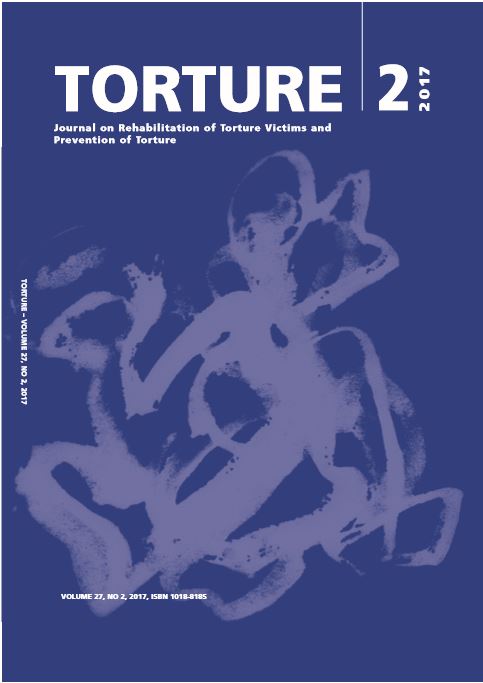Solitary confinement, Section 350, Evin prison in Tehran
DOI:
https://doi.org/10.7146/torture.v27i2.97221Keywords:
Iran, Solitary confinement, TortureAbstract
I was born in 1985 in Tehran, Iran. I started my political and human rights activism at university by founding a secular student association and publishing student magazines. Because of this, the university disciplinary committee did not allow me to study for two semesters. I was arrested by intelligence officials in 2008 and spent 38 days in solitary confinement in Evin prison (Tehran). That was the first time I was faced with psychological torture. During the repression after the presidential election in 2009, I was arrested for a second time. It was by the Revolutionary Guards (‘Sepah-e- Pasdaran’) and this time I spent about nine months in solitary confinement. This time marked me in many senses. Finally, because of those two incidents, I was convicted by the Revolutionary Court and sentenced to prison. After about six years in Section 350, Evin Prison, I was freed in 2014.References
Anson, V. (2009). White torture. In an interview with Blaze Hoseinpour on the site Rooz Online. Retrieved from http://www.roozonline.com/ persian/news/newsitem/archive/2009/agust/18/ article/0112e980714.html
Arasteh, Modabber, Sharifi Saqez, & Bayan. (2008). "The prevalence of psychiatric disorders in the Central Prison of Sanandaj", Journal of Fundamentals of Mental Health, No. 4, pp 316-311.
Arrigo, B., Leslie Bullock, J. (2008). “The Psychological Effect of solitary confinement on Prisoners in super max units”, International Journal of Offender Therapy and Comparative Criminology, 52. 6, 622-40.
Atkinson, R.L., et al (1987). Atkinson & Hilgard's Introduction to Psychology (Second Edition). Translator: Baraheni, Mn et al., Tehran: Roushd Print XXI.
Koestler, A. (2006). Interview with Death (Witness Spain), Translator: Deyhimi, N; Deyhimi, Xerxes. Tehran: Ney Publishing, Second Edition.
Grassian, S. (1983). Am J Psychiatry. 1983 Nov; 140(11):1450-4.
Grassian, S. (2006). Psychiatric effects of solitary confinement. Journal of Law and Policy, 22(617), 325–383.
Human Rights Watch (2009). Mental Illness, Human Rights and us prisons. Retrieved from https:// www.hrw.org/news/2009/09/22/mental-illnesshuman-rights-and-us-prisons
International Organization for Penal Reform, The. (2002). In prison practice: the application of international regulations in the prison. Tehran: Rah-e Tarbiat.
Palahang, H. et al (2002), Journal of Psychiatry and Clinical Psychology, Volume 8, Number 13, pp 64-57.
Hakimyoun, I. (2007), Iranian intelligence and security agencies until the end of Reza Shah, Tehran: Institute for Iranian Contemporary Historical Studies.
Mazaheri, M., et al (2011), "The prevalence of personality disorders among female prisoners of Zahedan prison", Journal of Research in Medical Sciences, Vol. 13, pp. 55-52
Mendez., J. UN Special Reporteur Statement on Solitary Confinement, 44570 § (2011). New York.
Mendez., J., & Mendez, J. (2013). Thematic Report- Standard Minimum Rules for the Treatment of Prisoners needs updating (Vol. 42285). Washington: United Nations.
National service frame work for mental health (2004). Samaritans Information Resource Pack, 2004, Retrieved from: www.mentalhealth.org.uk
O’Mara, S. (2009). Torturing the brain: on the folk
psychology and folk neurobiology motivating 'enhanced and coercive interrogation techniques'. Trends cogn sciences, Vol.13, Issue:12. pp 497-500.
Pérez-Sales P. (2016). Psychological torture. Definition, evaluation and measurement. Routledge Books.
Shalev, S. (2008). A sourcebook on solitary confinement. London: Mannheim Centre for Criminology. London School of Economics and Political Science.
Shams, A. (2007), General Science prison. Tehran: Rah-e Tarbiat Shariat, SV et al. (2006), "The prevalence of psychiatric disorders in male prisoners of Qasr prison in Tehran", the Faculty of Tehran University of Medical Sciences, Volume 63, Number 3, pp 36-25
United Nations Economic and Social Council (2015). United Nations Standard Minimum Rules for the Treatment of Prisoners (the Mandela Rules). Retrieved from: http://www. unodc.org/documents/commissions/CCPCJ/ CCPCJ_Sessions/CCPCJ_24/resolutions/L6/ ECN152015_L6_e_V1503048.pdf
Downloads
Published
How to Cite
Issue
Section
License
We accept that some authors (e.g. government employees in some countries) are unable to transfer copyright. The Creative Commons Licence Attribution-NonCommercial-NoDerivatives 4.0 International (CC BY-NC-ND 4.0) covers both the Torture Journal and the IRCT web site. The publisher will not put any limitation on the personal freedom of the author to use material contained in the paper in other works which may be published, provided that acknowledgement is made to the original place of publication.


